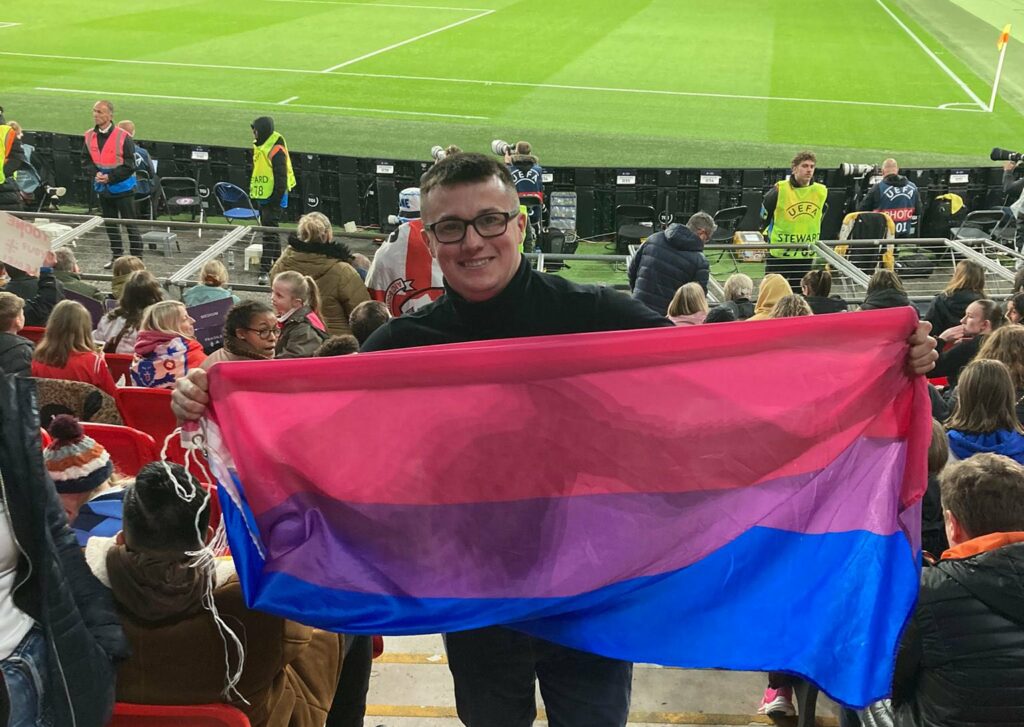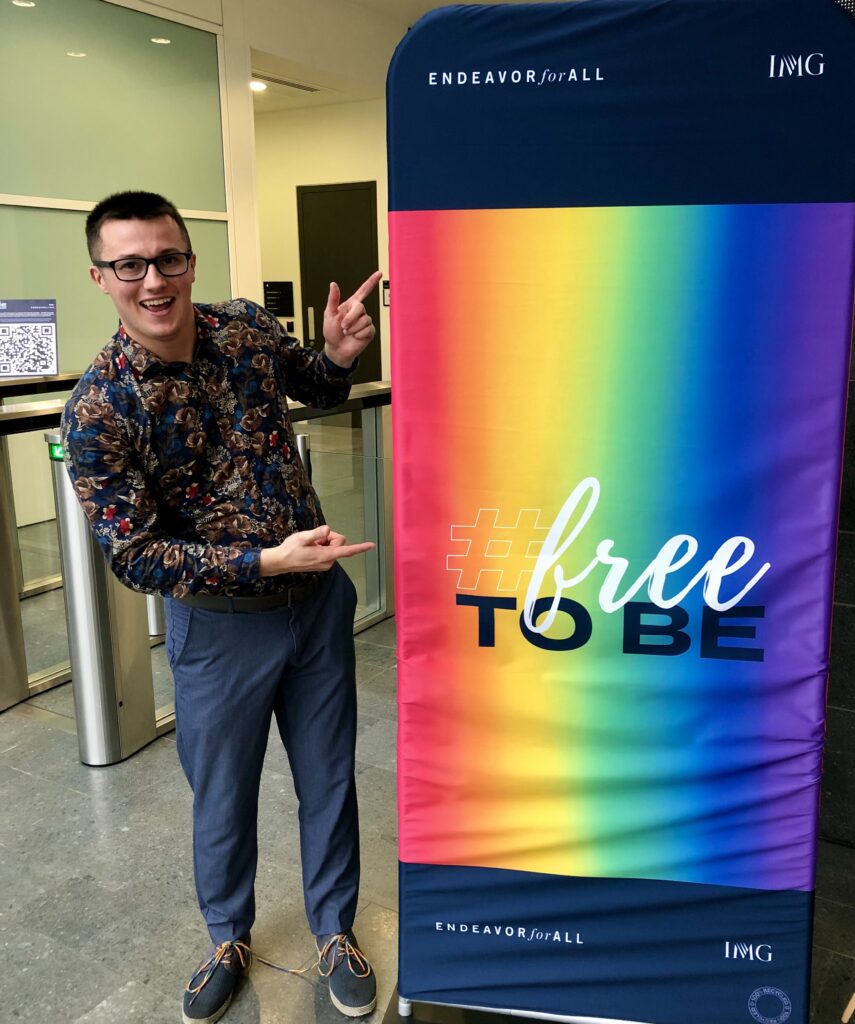Commentator Michael McCann on increasing LGBT+ representation in sports broadcasting
Michael McCann’s voice rises in the commentary booth as Sam Kerr pokes home Chelsea’s second in a comfortable 3-0 WSL victory away at Everton. It is not the only point of celebration for Kerr that week, however.
Live on the FA Player McCann announces: “Sam Kerr, of course, deserves our congratulations as of this week [with her] engagement confirmed to [US national team player] Kristie Mewis. Fantastic to see such open visibility. As a member of the LGBT+ community myself, it means a lot to have that in elite-level sport.”
McCann is a commentator working in both men’s and women’s football, including coverage of the EFL, WSL and UEFA Women’s Champions League, alongside work in hockey and cricket. He is also a vocal role model for the LGBT+ community.
LGBT+ issues remain underrepresented in the sports media, perhaps even more so in sports commentary. The most conservative of sports fans might even suggest commentary should solely focus on describing what is happening in front of them.
Yet, with millions tuning in to sports coverage every week, commentary could arguably be the most important medium to provide representation of social and political issues.
“As a commentator, you’re expected to contextualise the wider story of what an event means and socio-political context is a huge part of that,” McCann tells the Sports Gazette.
“Journalism is ultimately storytelling, and commentary is just one broadcast version of that. It’s about giving what this particular event means to this team and these players and what might be topical about them.
“If a TV commentator, in particular, was not giving you wider context about what the game means then that would not be an enjoyable listen.”

When McCann congratulated Kerr and Mewis he was contributing to the wider story of the match and what it meant for Kerr. In the context of sports media, where social and political issues can all too often be overlooked, he was also powerfully giving representation to the LGBT+ community.
“When I said that, I got a huge number of positive messages from people right across the world about feeling seen,” he says. “[The engagement] was an iconically cultural moment for the LGBT+ community, but I was also open about being part of that community myself. That helped people feel seen.”
Acceptance of LGBT+ people in the sports media is certainly improving. A survey by Sports Media LGBT+ in 2022 found that “18% of LGBT+ sports media surveyed are either in the closet at work or only out to their close work friends and colleagues”, down from 45% in 2018.
However, that still leaves one in five LGBT+ members of the sports media who do not feel safe to come out at work.
Broadcast journalism, and commentary in particular, has considerable potential to increase representation. The WSL saw 20.6 million people tune in to its TV coverage in the first half of 2023, while 8 million people watched Sky Sports’ coverage of the opening day of the 2023/24 season.

McCann is keen not to understate the importance that visible role models can have in helping minority groups feel welcome in sports media.
“When I was about 13, I knew that I wanted to work in sport, but I also knew that I was not heterosexual. I was scared if that would be possible because, even by that point, I had internalised what a macho, laddish culture sport seemed to be,” he says.
“Had I seen other men who were LGBT+ and working in broadcasting, that would have been a direct visible inspiration for me and would have helped me alleviate that fear a lot.
“It’s important to have LGBT+ broadcasters not hide who they are and be open about it. If we don’t openly talk about that and celebrate that difference and the perspective it brings, then change doesn’t happen as quickly.”
As well as its own members, the sports media can also contribute to increasing acceptance in sport for LGBT+ athletes.
Men’s football remains trailing behind in its inclusivity of LGBT+ athletes. Blackpool’s Jake Daniels is the only openly gay male professional footballer in the top four English divisions, though he is currently on loan to seventh-tier Bradford Park Avenue.
McCann has noticed a correlation between the visible representation of the LGBT+ community in women’s football media compared to men’s football media, and the culture of acceptance in the two sports.
“In women’s football, you have a space where discussing LGBT+ issues is just so much easier because the representation is there both on and off the pitch,” he comments. “Issues are discussed with a lot more nuance and sensitivity on the whole.”
In the past, there has been a tendency to sensationalise coverage of LGBT+ issues in sport. At times, coverage could be accused of barely looking past the ‘why are there not more openly gay athletes?’ question.
As McCann indicates, the sports media need to ensure they bring nuance to the issues at stake. While in commentary there may not be the same amount of time allocated to in-depth discussion, the same principles apply.
“Cover it in an authentically welcoming and accepting tone. Good coverage is built on a lack of sensationalism,” suggests McCann. “The stories are fascinating enough that if you listen to them and tell them, that’s more than enough.
“So long as your intent is not to take someone out of context or misrepresent them and you’re genuine in your tone and how you’re going about it.”
Sport Media LGBT+’s 2022 survey also indicated room for improvement. While it was a drop from 2018, 14% believed “their industry is underperforming on inclusion for people who aren’t heterosexual.” More concerningly, 81% believed “their industry is underperforming on inclusion for trans and non-binary people.”
McCann is keen to see more concerted coverage all-year round, rather than organisations only bothering during specific initiatives.
“Sports media can certainly improve, particularly on the men’s side, with being guilty of tick-boxing,” he elaborates. “Doing something like LGBT+ issues in a very surface-level way to say, ‘Yeah, we’ve done that, put it in its box and bring it back next year.’”
He cites the Rainbow Laces campaign, set up to highlight the experiences of LGBT+ athletes in sport. While acknowledging how impactful the campaign has been and continues to be, McCann worries media organisations only care during its dedicated campaign period.
“Sometimes, sadly, LGBT+ issues only get discussed once a year around that point, as opposed to being a meaningful, ongoing, detailed conversation,” he says.
“Everyone in sports media has a responsibility, not just across LGBT+ issues but all intersectionality, to try and educate yourselves and use sport as a vehicle for good, which I really believe it can be.”
When McCann congratulated Kerr and Mewis, he was adding relevant context to the story of the game. More importantly still, he was celebrating and normalising the visible representation of the LGBT+ community in sport.